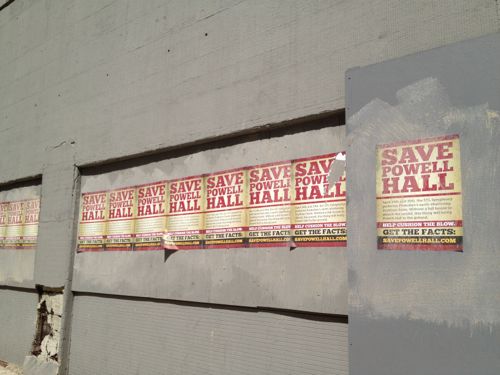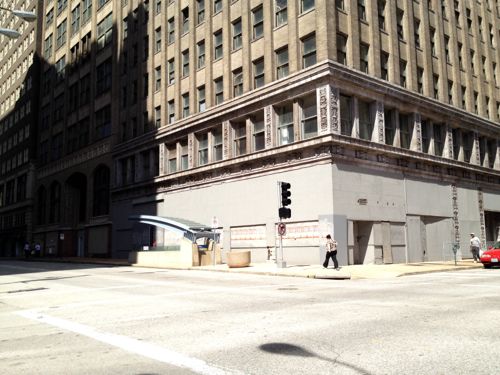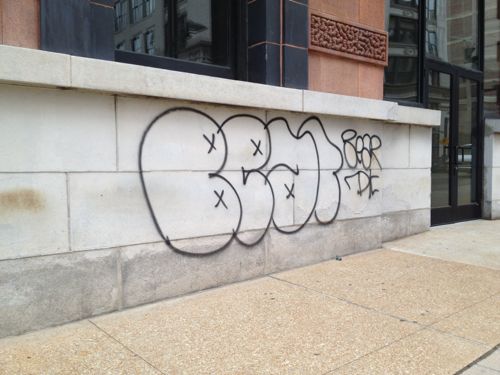Poll: Are Posted Handbills Urban Art Or Another Form of Graffiti?
Posted handbills, those posters often tacked up in urban cores, were the subject of a debate on a friend’s picture on Facebook. The photo was of handbills for the St. Louis Symphony’s new campaign called Save Powell Hall.

The debate went something like this:
- Friend A: Destruction of property, resulting in blight.
- Friend B: Not destructive but more colorful.
- Friend A: It’s illegal and will cost money to remove.
- Friend B: I like it, makes it look like something is happening
- Friend A: It’s ok to deface someone else’s property for your own interests?
- Friend C: Handbills are different than graffiti, removed by weather
- Friend B: Better than blank plywood
- Friend A: Project a negative image
- Friend D: Plywood isn’t a positive image
The debate continued but you get the point.

Gangs did “tag” numerous buildings downtown recently with graffiti.

Are handbills and spray paint equal? The poll is in the upper right sidebar, mobile users need to switch to the desktop layout to vote.
– Steve Patterson
If it’s not your property, what makes you think that you have any right to use or abuse it?!
A handbill anyone’s property but your own is “graffito,” and it should not be allowed. All “graffiti” forms should be viewed as destruction of private or municipal property, and offenders should be fined appropriately.
insert “placed on”
all of your choices come from the perspective that graffiti is “bad”. some of us may have a different view.
You wouldn’t mind tell us your address, would you? Some of us with a “different view” would like to come by.
Graffiti is bad on property that doesn’t belong to the artist.
In Denver, the official term is graffiti vandalism. There are two components, the “art” and/or the message and where it is placed. As they say, beauty is in the eye of the beholder – there is some graffiti that is very artistic, there is some that is just tagging and there is some that is downright offensive. The only real legal (and moral and social) issue, however, is one of placement, does the “artist” have permission to place his or her art in or on that location? If the answer is yes, then there is no vandalism, and the only question is one of artistic quality and/or the message it’s trying to communicate. If the answer is no, than it is, most likely, unwanted and it is vandalism. I don’t care if it is “a sign of life”. You wouldn’t like it I spray-painted the screen of your smartphone, and I doubt that Steve would embrace the “urbanity” if someone decided to plaster handbills all over the outside of his loft building. We can argue all we want whether plain painted plywood is preferable to decorated plywood, but the real issue is that the building is vacant, as are many others. If you want “signs of life”, then let’s get more people living and working in the city! And, no, more graffiti vandalism on more surfaces is not the answer!
Urban art is a commodity. Those who complain about property rights
would love a Banksy on their house. It would probably double their
market value.
So you’d be OK if the Crips decided to tag your property?!
“And, no, more graffiti vandalism on more surfaces is not the answer!”
Toronto has more graffiti than St. Louis has residents.
It also has the hottest condo market in North America.
Suggesting that graffiti drives people away from cities is incorrect.
A lot of people like it.
Just like how most people embrace other forms of petty and not-so-petty crime?
Perhaps the Symphony got permission from the building owner to post them?
I was pleased to see the ads on the former del taco near the hi-pointe; my thought was along the lines of “wow, like in a real city.” I wonder if they purposely pasted them to empty buildings? Certainly no shortage of those around here.
In some places graffiti can pass as art. I’m thinking primarily of the City of Tucson which does a remarkable job at managing graffiti as art. There is also the public dam walls in Wildwood where art was installed. Some would call it graffiti others art. At places like the water reservoir at Compton park, I always thought the walls would make a great place for some controlled graffiti highlighting scenes from around St. Louis. But graffiti there….NO way.
Controlled graffiti is an oxymoron.
Controlled graffiti is an oxymoron.